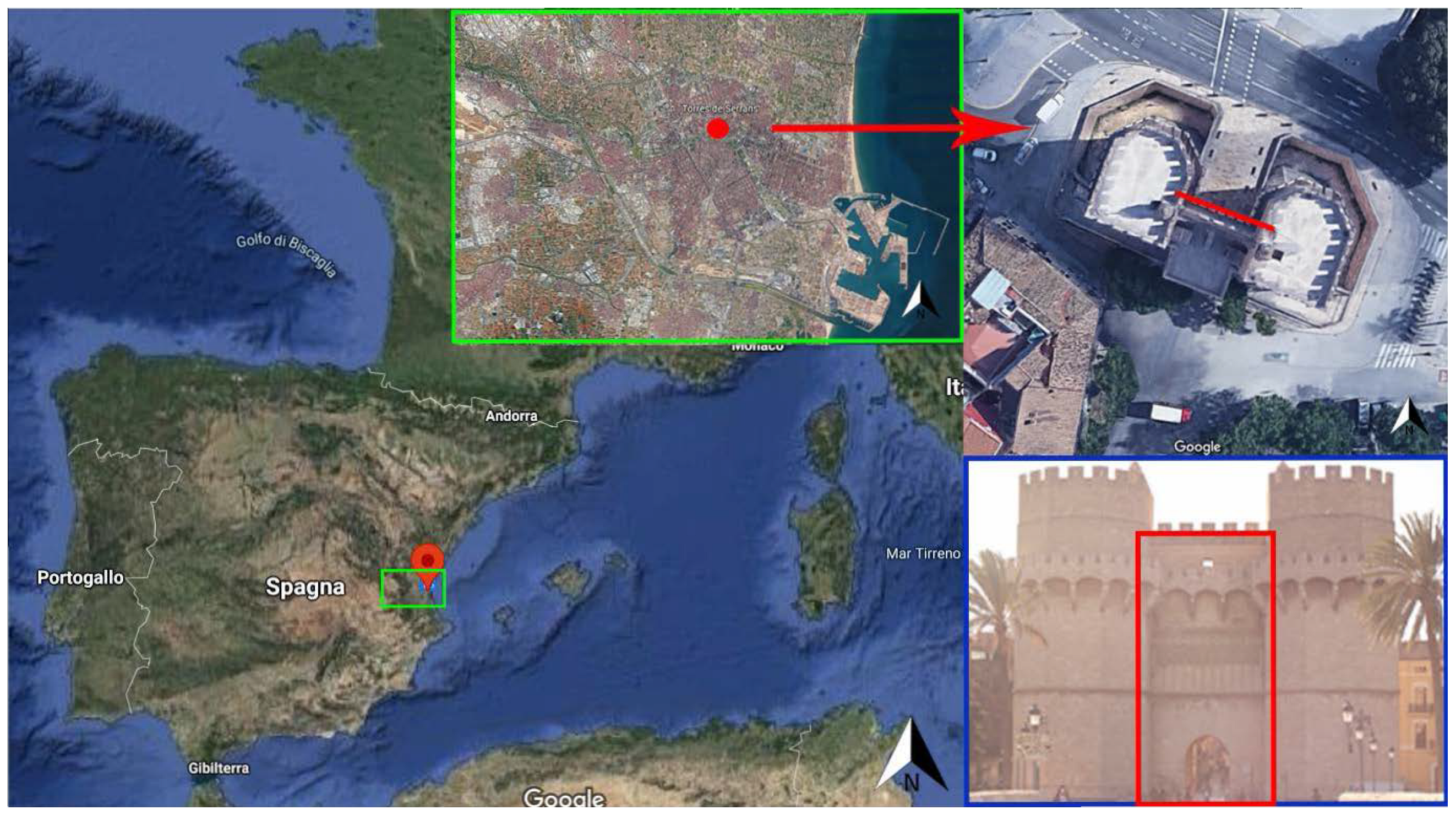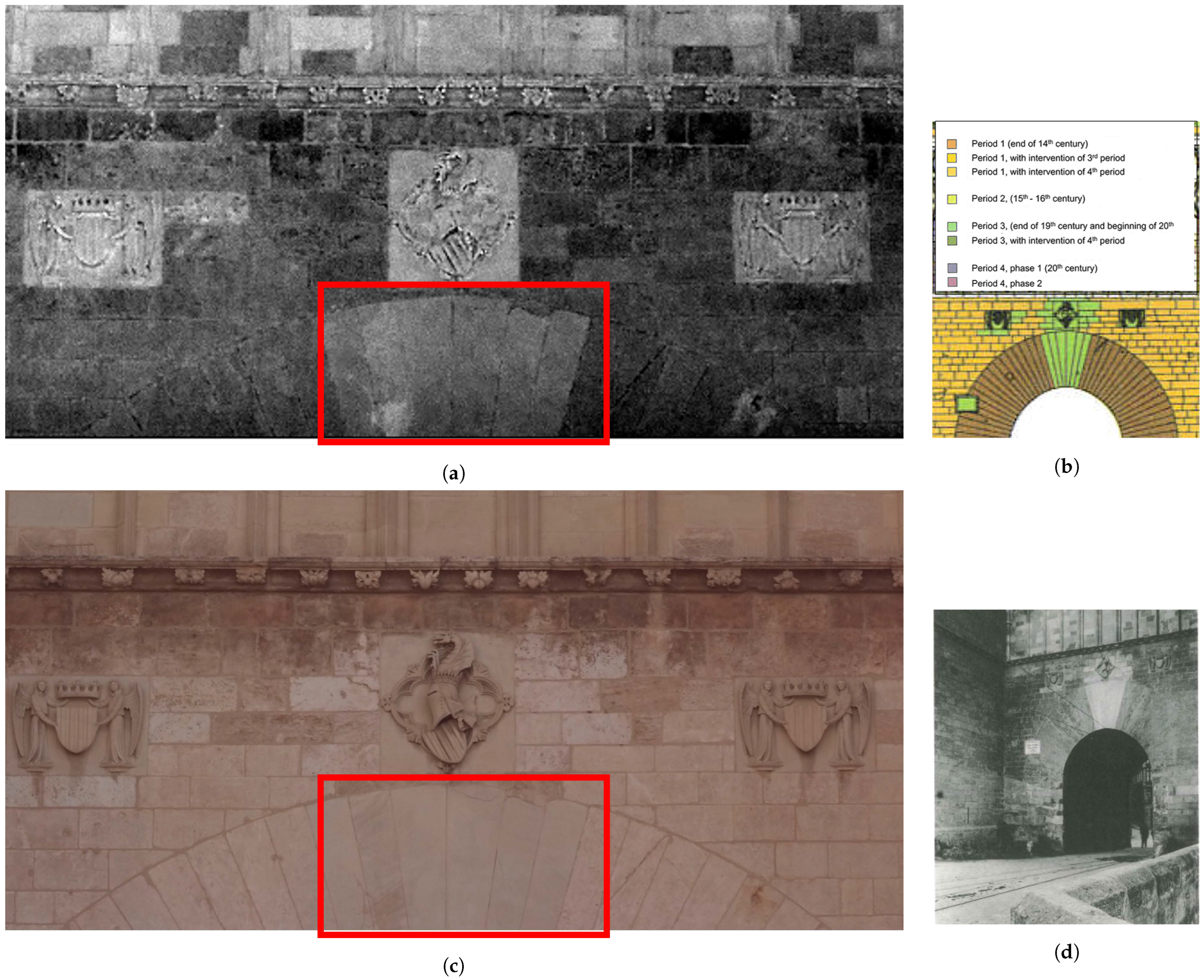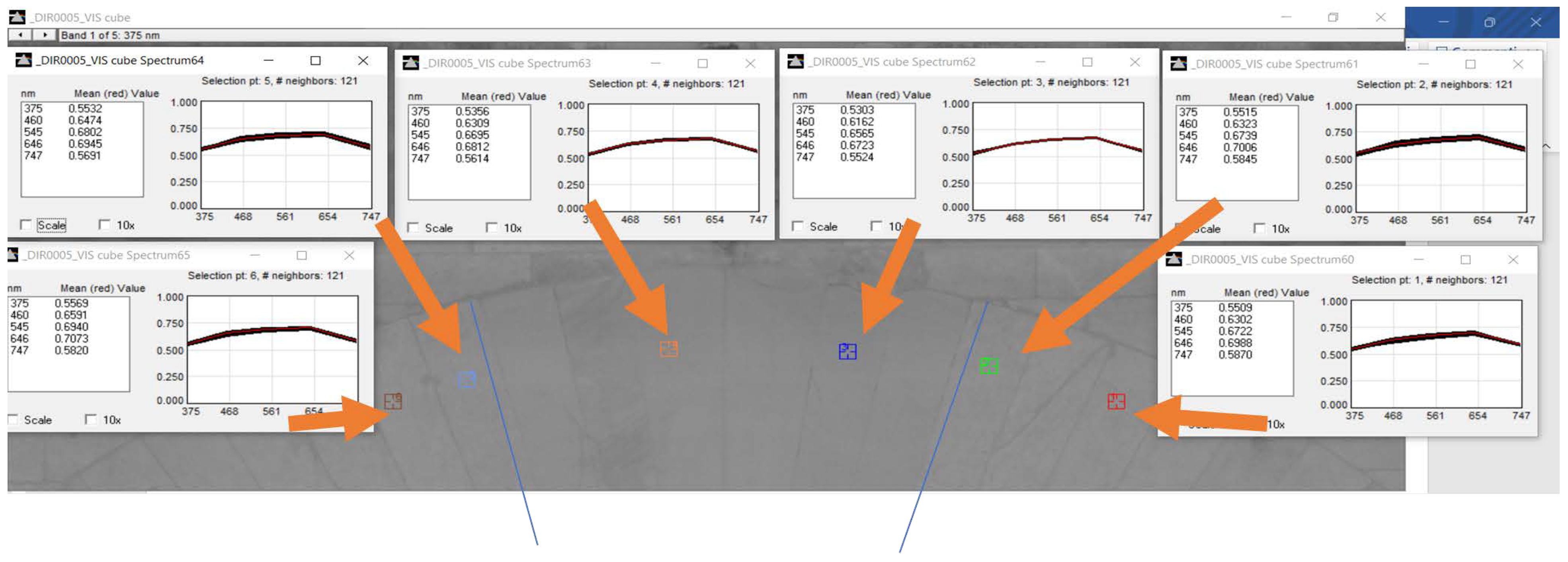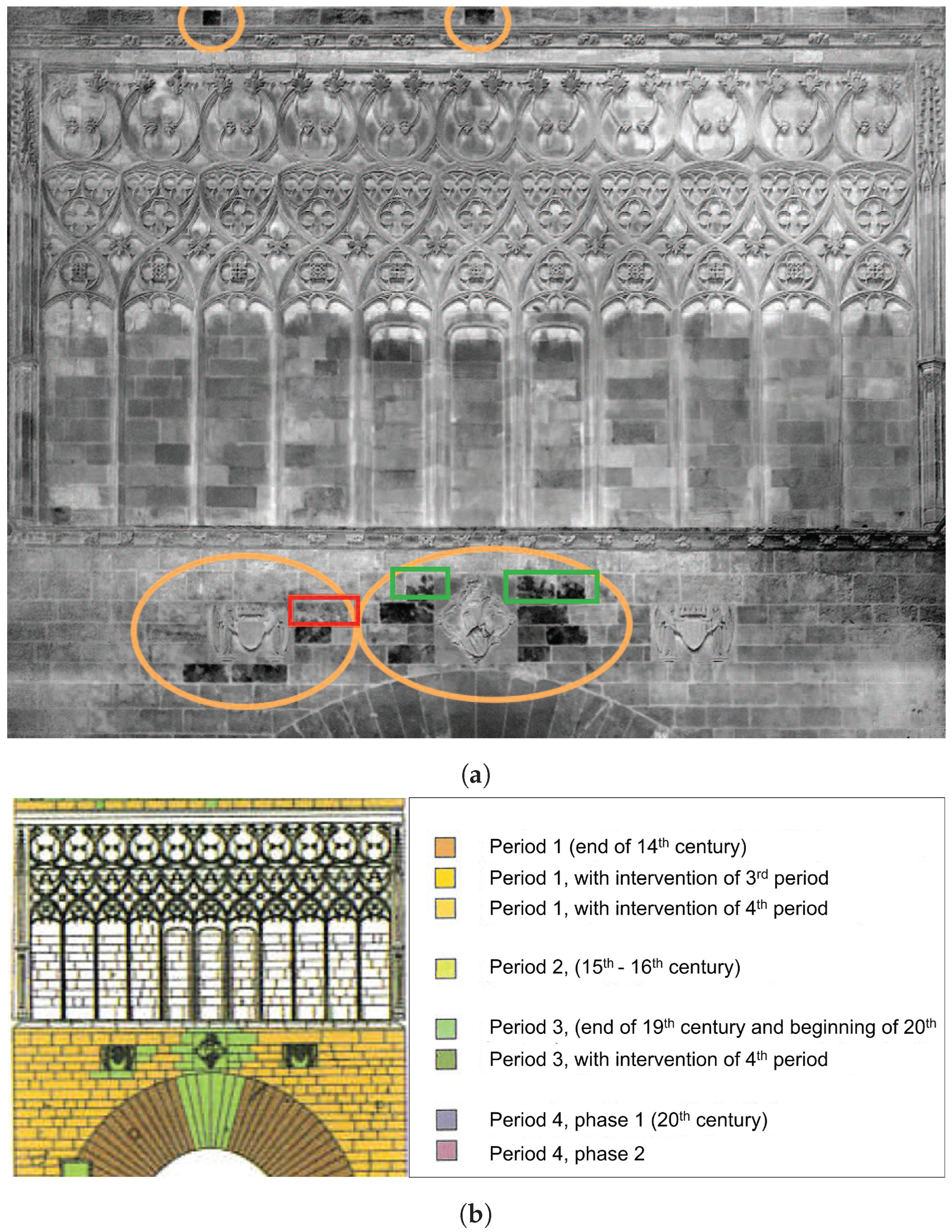Material Inspection of Historical Built Heritage with Multi-Band Images: A Case Study of the Serranos Towers in Valencia
Abstract
1. Introduction
2. Materials and Methods
2.1. Case Study
2.2. Multi-Band Survey
2.3. Pre-Processing
2.4. PC Analysis
3. Results
4. Discussion
5. Conclusions
Author Contributions
Funding
Data Availability Statement
Acknowledgments
Conflicts of Interest
Abbreviations
| NDT | Non-destructive techniques |
| NUV | Near-ultraviolet |
| VIS | Visible |
| NIR | Near-infraRed |
| TIR | Thermal infrared |
| LiDAR | Light detection and ranging |
| PCA | Principal component analysis |
| SLR | Single lens reflex |
| RGB | Red, green, and blue |
| GRL | Geospatial Research Laboratory |
| ERDC | Engineer Research and Development Centre |
| RMSE | Root mean square error |
| PCs | Principal components |
| CMOS | Complementary metal oxide semiconductor |
| CCD | Charge-coupled device |
References
- International Council on Monuments and Sites. International Charter for the conservation and restoration of monuments and sites (The Venice Charter 1964). In IInd International Congress of Architects and Technicians of Historic Monuments; International Council on Monuments and Sites: Venice, Italy, 1964; pp. 1–4. [Google Scholar]
- Galantucci, R.A.; Fatiguso, F. Advanced damage detection techniques in historical buildings using digital photogrammetry and 3D surface anlysis. J. Cult. Herit. 2019, 36, 51–62. [Google Scholar] [CrossRef]
- Meroño, J.E.; Perea, A.J.; Aguilera, M.J.; Laguna, A.M. Recognition of materials and damage on historical buildings using digital image classification. S. Afr. J. Sci. 2015, 111, 1–9. [Google Scholar] [CrossRef]
- Valença, J.; Gonçalves, L.M.; Júlio, E. Damage assessment on concrete surfaces using multi-spectral image analysis. Constr. Build. Mater. 2013, 40, 971–981. [Google Scholar] [CrossRef]
- Gonçalves, L.M.; Rodrigues, H.; Gaspar, F. Nondestructive Techniques for the Assessment and Preservation of Historic Structures; CRC Press: Boca Raton, FL, USA, 2017; pp. 1–262. [Google Scholar] [CrossRef]
- Sutherland, N.; Marsh, S.; Priestnall, G.; Bryan, P.; Mills, J. InfraRed Thermography and 3D-Data Fusion for Architectural Heritage: A Scoping Review. Remote Sens. 2023, 15, 2422. [Google Scholar] [CrossRef]
- Patrucco, G.; Gómez, A.; Adineh, A.; Rahrig, M.; Lerma, J.L. 3D data fusion for historical analyses of heritage buildings using thermal images: The Palacio de Colomina as a case study. Remote Sens. 2022, 14, 5699. [Google Scholar] [CrossRef]
- Sánchez, J.; Quirós, E. Semiautomatic detection and classification of materials in historic buildings with low-cost photogrammetric equipment. J. Cult. Herit. 2017, 25, 21–30. [Google Scholar] [CrossRef]
- Del Pozo, S.; Rodríguez-Gonzálvez, P.; Sánchez-Aparicio, L.J.; Muñoz-Nieto, A.; Hernández-López, D.; Felipe-García, B.; González-Aguilera, D. Multispectral imaging in cultural heritage conservation. ISPRS—Int. Arch. Photogramm. Remote Sens. Spat. Inf. Sci. 2017, XLII-2/W5, 155–162. [Google Scholar] [CrossRef]
- Manich, C.G.; Kelman, T.; Coutts, F.; Qiu, B.; Murray, P.; González-Longo, C.; Marshall, S. Exploring the use of image processing to survey and quantitatively assess historic buildings. In Structural Analysis of Historical Constructions Anamnesis, Diagnosis, Therapy, Controls; CRC Press: Boca Raton, FL, USA, 2016; pp. 125–132. [Google Scholar]
- Zollini, S.; Alicandro, M.; Dominici, D.; Quaresima, R.; Giallonardo, M. UAV photogrammetry for concrete bridge inspection using object-based image analysis (OBIA). Remote Sens. 2020, 12, 3180. [Google Scholar] [CrossRef]
- Lerma, J.L.; Akasheh, T.; Haddad, N.; Cabrelles, M. Multispectral sensors in combination with recording tools for cultural heritage documentation. Chang. Time 2011, 1, 236–250. [Google Scholar] [CrossRef]
- Del Pozo, S.; Herrero-Pascual, J.; Felipe-García, B.; Hernández-López, D.; Rodríguez-Gonzálvez, P.; González-Aguilera, D. Multispectral Radiometric Analysis of Façades to Detect Pathologies from Active and Passive Remote Sensing. Remote Sens. 2016, 8, 80. [Google Scholar] [CrossRef]
- Zahiri, Z.; Laefer, D.F.; Kurz, T.; Buckley, S.; Gowen, A. A comparison of ground-based hyperspectral imaging and red-edge multispectral imaging for façade material classification. Autom. Constr. 2022, 136, 104164. [Google Scholar] [CrossRef]
- Lerma, J.L.; Cabrelles, M.; Portalés, C. Multitemporal thermal analysis to detect moisture on a building faade. Constr. Build. Mater. 2011, 25, 2190–2197. [Google Scholar] [CrossRef]
- Lagüela, S.; González-Jorge, H.; Armesto, J.; Arias, P. Calibration and verification of thermographic cameras for geometric measurements. Infrared Phys. Technol. 2011, 54, 92–99. [Google Scholar] [CrossRef]
- Adamopoulos, E.; Tsilimantou, E.; Keramidas, V.; Apostolopoulou, M.; Karoglou, M.; Tapinaki, S.; Ioannidis, C.; Georgopoulos, A.; Moropoulou, A. Multi-sensor documentation of metric and qualitative information of historic stone structures. Isprs Ann. Photogramm. Remote Sens. Spat. Inf. Sci. 2017, IV-2/W2, 1–8. [Google Scholar] [CrossRef]
- Fischer, C.; Kakoulli, I. Multispectral and hyperspectral imaging technologies in conservation: Current research and potential applications. Stud. Conserv. 2006, 51, 3–16. [Google Scholar] [CrossRef]
- Masiero, A.; Costantino, D. TLS for detecting small damages on a building façade. Int. Arch. Photogramm. Remote Sens. Spat. Inf. Sci. 2019, XLII-2/W11, 831–836. [Google Scholar] [CrossRef]
- Adamopoulos, E.; Bovero, A.; Rinaudo, F. Image-based metric heritage modeling in the near-infrared spectrum. Herit. Sci. 2020, 8, 53. [Google Scholar] [CrossRef]
- Zahiri, Z.; Laefer, D.F.; Gowen, A. Characterizing building materials using multispectral imagery and LiDAR intensity data. J. Build. Eng. 2021, 44, 102603. [Google Scholar] [CrossRef]
- Lerma, J.L.; Cabrelles, M.; Akasheh, T.S.; Haddad, N. Documentation of Weathered Architectural Heritage with Visible, near Infrared, Thermal and Laser Scanning Data. Int. J. Herit. Digit. Era 2012, 1, 251–275. [Google Scholar] [CrossRef]
- Mileto, C.; Vegas, F.; Lerma, J.L. Multidisciplinary Studies, Crossreading and Transversal Use of Thermography: The Castle of Monzón (Huesca) as a case study. In Defensive Architecture of the Mediterranean. XV to XVIII Centuries; Editorial Universitat Politècnica de València: Valencia, Spain, 2015; pp. 405–412. [Google Scholar] [CrossRef][Green Version]
- De Fino, M.; Bruno, S.; Fatiguso, F. Dissemination, assessment and management of historic buildings by thematic virtual tours and 3D models. Virtual Archaeol. Rev. 2022, 13, 88–102. [Google Scholar] [CrossRef]
- Lužnik-Jancsary, N.; Horejs, B.; Klein, M.; Schwall, C. Integration and workflow framework for virtual visualisation of cultural heritage. Revisiting the tell of Çukuriçi Höyük, Turkey. Virtual Archaeol. Rev. 2020, 11, 63–74. [Google Scholar] [CrossRef]
- Alicandro, M.; Candigliota, E.; Dominici, D.; Immordino, F.; Quaresima, R.; Zollini, S. Alba fucens archaeological site: Multiscale and multidisciplinary approach for risk assessment and conservation. Int. Arch. Photogramm. Remote Sens. Spat. Inf. Sci. 2019, 42, 47–53. [Google Scholar] [CrossRef]
- Abate, N.; Frisetti, A.; Marazzi, F.; Masini, N.; Lasaponara, R. Multitemporal–Multispectral UAS Surveys for Archaeological Research: The Case Study of San Vincenzo Al Volturno (Molise, Italy). Remote Sens. 2021, 13, 2719. [Google Scholar] [CrossRef]
- Asscher, Y.; Angelini, I.; Secco, M.; Parisatto, M.; Chaban, A.; Deiana, R.; Artioli, G. Combining multispectral images with X-ray fluorescence to quantify the distribution of pigments in the frigidarium of the Sarno Baths, Pompeii. J. Cult. Herit. 2019, 40, 317–323. [Google Scholar] [CrossRef]
- Rahrig, M.; Herrero Cortell, M.Á.; Lerma, J.L. Multiband Photogrammetry and Hybrid Image Analysis for the Investigation of a Wall Painting by Paolo de San Leocadio and Francesco Pagano in the Cathedral of Valencia. Sensors 2023, 23, 2301. [Google Scholar] [CrossRef] [PubMed]
- Martinho, E.; Dionisio, A. Nondestructive and micro-invasive techniques for stone cultural heritage diagnosis: An overview. Adv. Mater. Sci. Res. 2016, 22, 1–30. [Google Scholar]
- Menéndez, B. Non-destructive techniques applied to monumental stone conservation. In Non-Destructive Testing; IntechOpen: Rijeka, Croatia, 2016; pp. 1–42. [Google Scholar]
- Pronti, L.; Romani, M.; Verona-Rinati, G.; Tarquini, O.; Colao, F.; Colapietro, M.; Pifferi, A.; Cestelli-Guidi, M.; Marinelli, M. Post-Processing of VIS, NIR, and SWIR Multispectral Images of Paintings. New Discovery on the The Drunkenness of Noah, Painted by Andrea Sacchi, Stored at Palazzo Chigi (Ariccia, Rome). Heritage 2019, 2, 2275–2286. [Google Scholar] [CrossRef]
- Gonzalez, R.C.; Woods, R.E.; Prentice Hall, P. Digital Image Processing Third Edition; Pearson Education, Inc.: Upper Saddle River, NJ, USA, 2009; p. 976. [Google Scholar]
- Piroddi, L.; Calcina, S.V.; Trogu, A.; Vignoli, G. Towards the Definition of a Low-Cost Toolbox for Qualitative Inspection of Painted Historical Vaults by Means of Modified DSLR Cameras, Open Source Programs and Signal Processing Techniques. In Proceedings of the Lecture Notes in Computer Science (Including Subseries Lecture Notes in Artificial Intelligence and Lecture Notes in Bioinformatics), Cagliari, Italy, 1–4 July 2020; Springer Science and Business Media Deutschland GmbH: Berlin, Germany, 2020; Volume 12255 LNCS, pp. 971–991. [Google Scholar] [CrossRef]
- Hatir, M.E.; Barstuğan, M.; Ince, I. Deep learning-based weathering type recognition in historical stone monuments. J. Cult. Herit. 2020, 45, 193–203. [Google Scholar] [CrossRef]
- Abdi, H.; Williams, L.J. Principal component analysis. In Wiley Interdisciplinary Reviews: Computational Statistics; Wiley Online Library: New York, NY, USA, 2010; Volume 2, pp. 433–459. [Google Scholar] [CrossRef]
- Rodarmel, C.; Shan, J. Principal Component Analysis for Hyperspectral Image Classification. Inf. Syst. 2002, 62, 115–123. [Google Scholar]
- De Silva, W.; Habermann, M.; Shiguemori, E.H.; Do Livramento Andrade, L.; De Castro, R.M. Multispectral image classification using multilayer perceptron and principal components analysis. In Proceedings of the 1st BRICS Countries Congress on Computational Intelligence, BRICS-CCI 2013, Ipojuca, Brazil, 8–11 September 2013; pp. 557–562. [Google Scholar] [CrossRef]
- Capobianco, G.; Pronti, L.; Gorga, E.; Romani, M.; Cestelli-Guidi, M.; Serranti, S.; Bonifazi, G. Methodological approach for the automatic discrimination of pictorial materials using fused hyperspectral imaging data from the visible to mid-infrared range coupled with machine learning methods. Spectrochim. Acta Part A Mol. Biomol. Spectrosc. 2024, 304, 123412. [Google Scholar] [CrossRef]
- Adriaens, A. Non-destructive analysis and testing of museum objects: An overview of 5 years of research. Spectrochim. Acta Part B At. Spectrosc. 2005, 60, 1503–1516. [Google Scholar] [CrossRef]
- Lanteri, L.; Agresti, G.; Pelosi, C. A New Practical Approach for 3D Documentation in Ultraviolet Fluorescence and Infrared Reflectography of Polychromatic Sculptures as Fundamental Step in Restoration. Heritage 2019, 2, 207–215. [Google Scholar] [CrossRef]
- Marchioro, G.; Daffara, C. PCA-based method for managing and analyzing single-spot analysis referenced to spectral imaging for artworks diagnostics. MethodsX 2020, 7, 100799. [Google Scholar] [CrossRef] [PubMed]
- George, S.; Grecicosei, A.M.; Waaler, E.; Hardeberg, J.Y. Spectral Image Analysis and Visualisation of the Khirbet Qeiyafa Ostracon. In Proceedings of the Lecture Notes in Computer Science (Including Subseries Lecture Notes in Artificial Intelligence and Lecture Notes in Bioinformatics), Cherburg, France, 30 June–2 July 2014; Volume 8509 LNCS, pp. 272–279. [Google Scholar] [CrossRef]
- Tonazzini, A.; Salerno, E.; Abdel-Salam, Z.A.; Harith, M.A.; Marras, L.; Botto, A.; Campanella, B.; Legnaioli, S.; Pagnotta, S.; Poggialini, F.; et al. Analytical and mathematical methods for revealing hidden details in ancient manuscripts and paintings: A review. J. Adv. Res. 2019, 17, 31–42. [Google Scholar] [CrossRef] [PubMed]
- Rahiche, A.; Hedjam, R.; Al-maadeed, S.; Cheriet, M. Historical documents dating using multispectral imaging and ordinal classification. J. Cult. Herit. 2020, 45, 71–80. [Google Scholar] [CrossRef]
- Cervera Arias, F.; Mileto, C. Las Torres de Serranos, Historia y Restauración; Ajuntament de Valencia: Valencia, Spain, 2003. [Google Scholar]
- Mileto, C.; Cervera Arias, F. La restauración de las Torres de Serranos de Valencia. Loggia Arquit. Restaur. 2003, XII, 114. [Google Scholar] [CrossRef][Green Version]
- Machine Vision Filters|MidOpt. Available online: https://midopt.com/ (accessed on 21 July 2022).
- HyperCube, Engineer Research and Development Center. Available online: https://www.erdc.usace.army.mil/Media/Fact-Sheets/Fact-Sheet-Article-View/Article/610433/hypercube/ (accessed on 21 July 2022).
- Lerma, J.L. Multiband versus multispectral supervised classification of architectural images. Photogramm. Rec. 2001, 17, 89–101. [Google Scholar] [CrossRef]








Disclaimer/Publisher’s Note: The statements, opinions and data contained in all publications are solely those of the individual author(s) and contributor(s) and not of MDPI and/or the editor(s). MDPI and/or the editor(s) disclaim responsibility for any injury to people or property resulting from any ideas, methods, instructions or products referred to in the content. |
© 2024 by the authors. Licensee MDPI, Basel, Switzerland. This article is an open access article distributed under the terms and conditions of the Creative Commons Attribution (CC BY) license (https://creativecommons.org/licenses/by/4.0/).
Share and Cite
Alicandro, M.; Mileto, C.; Lerma, J.L. Material Inspection of Historical Built Heritage with Multi-Band Images: A Case Study of the Serranos Towers in Valencia. Remote Sens. 2024, 16, 3167. https://doi.org/10.3390/rs16173167
Alicandro M, Mileto C, Lerma JL. Material Inspection of Historical Built Heritage with Multi-Band Images: A Case Study of the Serranos Towers in Valencia. Remote Sensing. 2024; 16(17):3167. https://doi.org/10.3390/rs16173167
Chicago/Turabian StyleAlicandro, Maria, Camilla Mileto, and José Luis Lerma. 2024. "Material Inspection of Historical Built Heritage with Multi-Band Images: A Case Study of the Serranos Towers in Valencia" Remote Sensing 16, no. 17: 3167. https://doi.org/10.3390/rs16173167
APA StyleAlicandro, M., Mileto, C., & Lerma, J. L. (2024). Material Inspection of Historical Built Heritage with Multi-Band Images: A Case Study of the Serranos Towers in Valencia. Remote Sensing, 16(17), 3167. https://doi.org/10.3390/rs16173167








